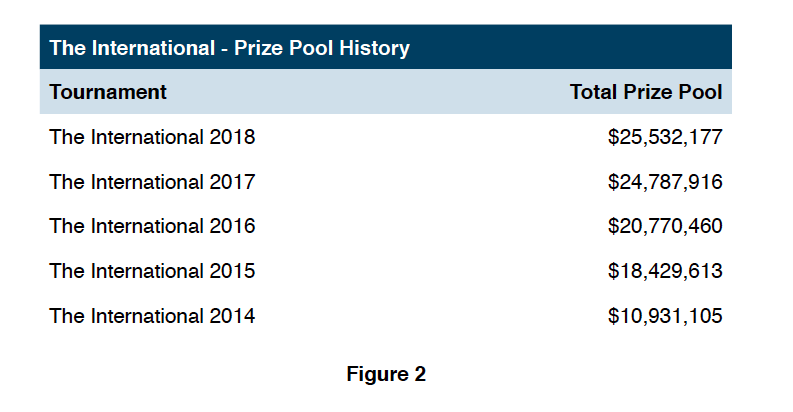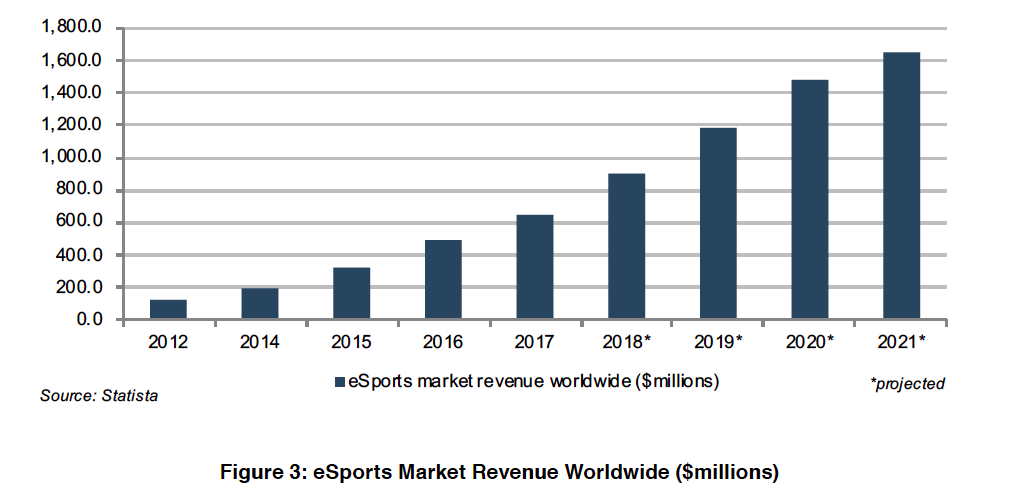Valuing an eSports Team
The value of a company is generally dependent on three factors: risk, growth, and cash flow. Esports teams have an abundance of risk as well as growth potential. Considering eSports is a relatively new industry, the growth potential is huge. At the same time, and for the same reason, there is significant risk in the industry – it is too early to know if there is a proven, sustainable, cash flow generating business model.
Risk
Sustainability is one of the key risk factors for eSports teams. Viewer interest in games changes rapidly as new games are released. For the week of September 4, 2017, PLAYERUNKNOWNS’S BATTLEGROUNDS (“PUBG”) was the most viewed game with 112,741 average Twitch viewers. League of Legends (94,940) and Hearthstone (58,427) completed the top three. One year later, for the week of September 3, 2018, Fortnite led the way with 163,303 viewers while Counter-Strike: Global Offensive (129,580), and League of Legends (109,210) completed the top three. Hearthstone dropped to 36,849 average Twitch viewers for the week and PUBG dropped to 33,877 average Twitch viewers. Tracking viewership trends and competing in games that are popular is an important skill for teams that want to maintain relevance. Team Liquid’s CEO, Steve Arhancet, indicated the team looks for multiplayer games that have a thriving competitive community and are enjoyable to watch and play. Game publishers are another source of risk for eSports teams. The soon to be started Overwatch League (“OWL”) has a total buy-in price of $20 million split among its 20 teams. The high up-front cost to participate in the league has made some teams avoid the league.
Esports teams also have risks related to their players. Since eSports is not yet an established industry, there is not a set protocol for player contracts that allows teams to keep players for a long period of time. In addition, eSports teams must consider team dynamics when assembling a roster much like other professional team sports such as basketball, football, or hockey. If an eSports team does not have chemistry, it is unlikely they will perform at a high level. Frisco, Texas based eSports team CompLexity cited roster instability as a reason they dropped their Overwatch team.
Growth
As shown in the chart below, the industry has been growing rapidly over recent years.

Esports industry research firm NewZoo projects 380 million total viewers in 2018, with 57% of those classified as frequent viewers/enthusiasts and 43% classified as occasional viewers. The compound annual growth rate of total viewers is projected to be 13.55% from 2017 to 2021.
Another area where growth can be observed is the prize pool for major eSports tournaments. For example, The International 8, held in 2018 set a record for the largest single tournament prize pool in eSports history for the fifth consecutive year at $25.5 million. Prior iterations of The International had prize pools as shown in Figure 2. The compound annual growth rate of the prize pool from 2014 to 2018 was 24%.

Newzoo defines industry revenue as the amount generated through the sale of sponsorships, media rights, advertising, publisher fees, tickets, and merchandising. Global eSports revenues are projected to reach $906 million in 2018. North America is projected to account for approximately 38% ($345 million) of global eSports revenue in 2018. As shown in Figure 3, global revenue for eSports is projected to reach $1.65 billion in 2021.

Cash Flow
Mercer Capital’s “eSports Business Models” shows how eSports teams make money and the costs of revenue associated with those income streams. Generally speaking, eSports teams have the following sources of revenue: sponsorships, broadcast revenue, merchandise sales, prize money, and naming rights. Costs of revenue include: player salaries, administrative personnel salaries, player housing expenses, training facility rent or operating expense, travel costs, and equipment/accessory expense. In broad terms, cash flow is calculated by subtracting operating expenses from total revenue.
Revenue can have different tiers of riskiness. For example, recurring revenue from sponsorships and subscriptions is less risky than merchandise sales or prize money. All else equal, teams with a higher ratio of recurring revenue to non-recurring revenue are considered less risky than a team with more non-recurring revenue than recurring revenue. Teams with lower risk cash flow are considered more valuable than teams with riskier cash flow.
Valuing an eSports Team
There are three approaches to value that are used or considered in any valuation. The three approaches to value are the cost approach, the income approach, and the market approach. This section walks through how an eSports team would be valued using each approach. Usually, valuation firms weight indications from each approach to arrive at a final conclusion of value.
Cost Approach
The cost approach is applied by adjusting the subject entity’s assets and liabilities to market value. Liabilities are then subtracted from assets to arrive at net asset value. A typical eSports team would have mostly intangible assets such as players. Tangible assets would be training facilities or team headquarters owned by the team. The cost approach, in many instances, would be weighted lightly, if at all, because it does not fully account for intangible assets.
Income Approach
The income approach is applied by calculating the cash flow either for a single period or for a projected multi-year period. At this stage, multi-year projections that account for potential growth will be the most common method employed. Capitalization at this point would be less likely to be used as growth has not stabilized within the industry. The risk and growth factors that would be considered for an eSports team will be the lynchpin to reasonably and properly measuring value. For an operating eSports team, the income approach would most likely be the heaviest weighted indication in a conclusion of value.
Market Approach
The market approach is similar to the income approach in that some element of cash flow is capitalized by some factor. However, in the market approach the capitalization factor is estimated using multiples indicated by public companies or transactions of private companies in the same or similar lines of business as the subject company. The market approach could be difficult to apply to an eSports team because, even though teams operate in the same general industry of eSports, there are many unique factors to each team. Within the market approach, cash flow, the capitalization factor(s)/multiple(s), or both may be adjusted based on how the subject team compares to the teams selected in the market approach. As the industry matures and more transactions occur, the market approach will develop alongside the industry.
Conclusion
In summary, eSports teams are valued using three methods: the cost approach, the market approach, and the income approach. Each of the methods considers three primary factors: risk, growth, and cash flow. Each eSports team is unique and there is no single formulaic way to value a team. However, in general, eSports teams will likely be valued using their historical and projected cash flows in the income approach. As the industry develops and matures there will be more transactions within the industry which will allow the market approach to become a more widely used tool.
Originally published in Mercer Capital’s Valuing an eSports Team whitepaper.


